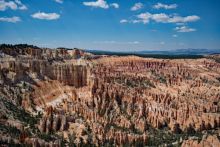Geoscience Currents transmit snapshots of the many facets of the geoscience profession, in-depth case studies of how geoscience is applied, factsheets that provide rigorous introductions to a range of geoscience topics, workforce trends, and career paths.
Partner with us to help support well-informed public policy and decision making with expert, impartial geoscience information. Visit our Sponsorships page for more information or email sponsorships@americangeosciences.org.
Displaying 331 - 340 of a total of 350 items

May 11, 2009
Science and engineering employment comprises 1 to 3 percent of total state employment. States with the highest science and engineering employment as a percentage of total state employment are the District of Columbia (5%), and Arkansas, California, Colorado, Massachusetts, Maryland, Michigan, New...

March 30, 2009
From the end of 2008 through the early part of 2009, an increasing number of representatives from academic institutions began expressing concerns about the viability of their geoscience programs in the face of cutbacks due to the economic downturn. To etter assess this situation, the American...

January 15, 2009
Since 1996, the majority of new geoscience Ph.D. graduates have entered into academic positions (both post-doctoral (PD) and non-postdoctoral (non PD)). Of note, is the increase in new geoscience Ph.D. recipients taking academic post-doctoral positions since 2000. This is due to a variety of...

November 25, 2008
A common assertion is that the number of geoscience degrees granted is dependent on the price of oil. However, this metric requires a response lag greater than oil price change velocity. A more responsive mechanism would likely be the rate of degree completion – that students would be incentivized...

October 09, 2008
The majority of geoscientists in the workforce are within 15 years of retirement age. Data from federal sources, professional societies, and industry indicate the imbalance of the age of geoscientists in the profession. The percentage of geoscientists between 31 and 35 years of age is less than...

September 26, 2008
The states with the lowest percentage of under-represented minorities have relatively small populations with more than 50% of the people living in rural areas. The under-represented population includes Black and African American, American Indian and Alaska Natives, Native Hawaiian and other Pacific...

September 15, 2008
Total federal funding for geoscience research has leveled off since 2003, as have the proportions of funding for atmospheric science, geological science, and oceanography. Since the mid-1980’s however, the percentage of geoscience research funding applied to interdisciplinary geosciences has...

July 22, 2008
The states with the most geoscience departments are in California, New York, and Pennsylvania. Students in states that have a larger number of universities with geoscience departments will, in general, have a greater diversity of options to major in the field in their region.

July 09, 2008
Tenure-track geoscience faculty progress steadily through the academic ranks from assistant professor to full professor by the age of 60. Full professors tend to work later into their career, and there is a cross-over in the population of full professors and emeritus in the 71-75 age range.
The...

June 27, 2008
Individuals who hold terminal geoscience master’s or doctoral degrees have similar academic backgrounds. Both groups have comparable percentages of bachelor degrees in business (~ 1%), engineering (12-17%), geosciences (50-56%), other science & mathematics (18-19%), and other degree fields (12-...
Pages
Upcoming Webinars


